

 | Energy Engineering |  |
DOI: 10.32604/ee.2022.019200
REVIEW
Prospects and Challenges of Utilizing Solar Energy for the COVID-19 Vaccine Cold Storage in Remote Clinics of Tropical Countries: Review
1Department of Mechanical Engineering Education, Universitas Pendidikan Indonesia, Bandung, 40154, Indonesia
2Department of Mechanical Engineering Education, Universitas Sebelas Maret, Surakarta, 57126, Indonesia
3Department of Mechanical Engineering, Institute Teknologi Bandung, Bandung, 40116, Indonesia
*Corresponding Authors: Indra Mamad Gandidi. Email: indra.gandidi@upi.edu; Nugroho Agung Pambudi. Email: agung.pambudi@staff.uns.ac.id
Received: 08 September 2021; Accepted: 10 February 2022
Abstract: The rapid spread of COVID-19 pandemic has forced several countries in the world to store vaccines in cold storage towards ensuring their protection from being damaged and to maintain their stability. However, most remote clinics, especially those in the equator and islands, are faced with the challenges of hot climates and the inability to afford electricity resources needed to power the cold storage facility. Meanwhile, the hot equatorial region has abundant solar energy to power the vaccine cold storage but previous studies showed that several field workers do not have the ability to maintain the vaccine storage temperature as indicated by the manufacturer’s recommendations. Therefore, this literature review study examines the prospects and challenges of implementing solar-powered cold storage to provide cooling space for remote clinics. This is expected to contribute significantly to cold chain vaccine management technology. The findings showed that four technology integration schemes including Cold Storage Ice Maker, Cold Storage Ice Maker-PCM, Refrigerator-Ice Maker and, Absorbing Cooling-PV-Ice Maker have the potential to be applied in clinics situated in certain tropical regions.
Keywords: COVID-19; vaccine; cold storage; solar power; remote clinic
Nomenclature
| coefficient of performance | |
| specific heat at constant pressure | |
| circulation ratio | |
| specific enthalpy | |
| water | |
| lithium bromide | |
| lithium nitrate | |
| mass flow rate | |
| sodium thiocyanate | |
| ammonia | |
| pressure | |
| heat transfer | |
| entropy | |
| temperature | |
| mechanical power | |
| mass fraction |
Subscripts
| first stage | |
| second stage | |
| absorber | |
| condenser | |
| compressor | |
| inter-exchanger solution | |
| input | |
| evaporator | |
| refrigerant | |
| generator | |
| liquid | |
| weak solution | |
| rich solution | |
| vapor |
Abbreviation
| AC | Alternating Current |
| COP | Coefficient of Performance |
| COVID-19 | Coronavirus Disease of 2019 |
| DC | Direct Current |
| PCM | Phase Change Materials |
| PV | Photovoltaics |
| UK | United Kingdom |
| USA | United States of America |
| WHO | World Health Organization |
The world is currently focused on solving the COVID-19 pandemic problem which has caused human and economic losses [1] with several countries reported to have implemented lockdowns and restrictions on social interaction to prevent wider spread of the virus [2,3]. This lockdown policy was found to have led to a reduction in the spread rate [4–6] but posed a threat of worsening the previous economic downturn [7–9].
Another strategy used by governments to minimize the mortality rate was through the provision of vaccines [10–12] but several challenges are associated with the efforts towards reaching the minimum number of vaccinations targeted [13]. An example of this is the maintenance of the stability of the vaccine storage according to the manufacturer’s recommendations [14]. Meanwhile, the data on the vaccines with distribution permits are presented in Table 1.

The storage of these vaccines is becoming increasingly difficult in tropical countries due to hot environmental temperatures as indicated in Fig. 1 where the average value is 29°C [24] and this is higher than the values in other regions. Sunlight is normally stable for 12 h/day in the tropics and countries with island regions have additional challenges due to the fact that there is no easy access to electrical energy. Moreover, there is need to transport vaccines across a wide ocean in archipelagic areas in addition to the lack of on-grid access to electricity. This makes it difficult to provide effective cold storage which does not depend on on-grid energy sources for vaccines in hot tropical areas. This is particularly important because of the need to position vaccine supply chain resilience in a multi-network context [25]. The process of distributing these vaccines is, however, presented in the following Fig. 1.
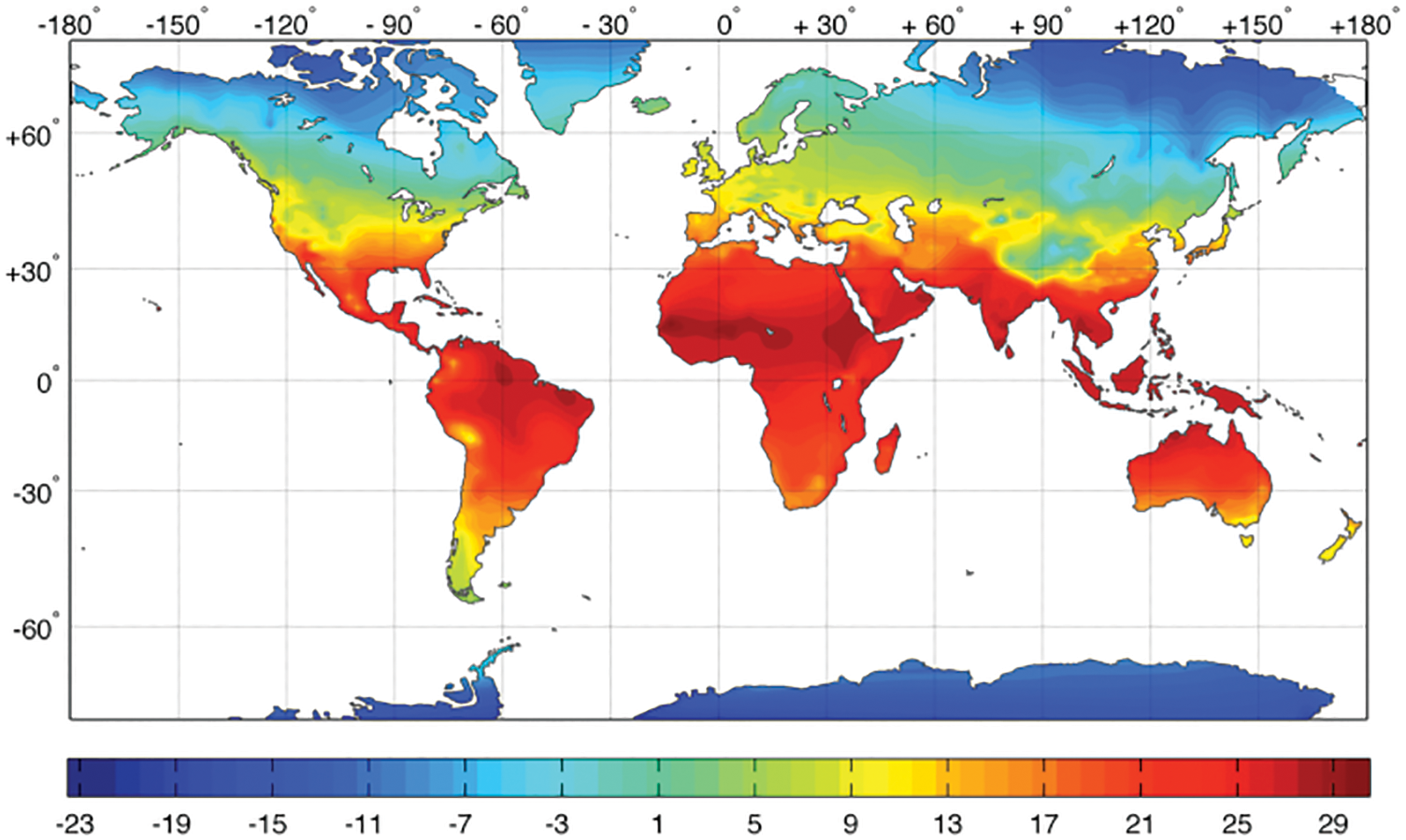
Figure 1: Global distribution of annual mean temperature in °C [24]
To meet the need for vaccines, the government needs to provide standard cold storage units classified into 5 parts, namely national vaccine store, provincial vaccine store, district vaccine store, health center and outreach based on Fig. 2 [17]. This is necessary to provide a clear description of vaccine delivery methods to remote areas, infrastructure implementation, and necessary vaccine delivery modifications [25]. The examples of some vaccine cold storage are shown in Fig. 3.
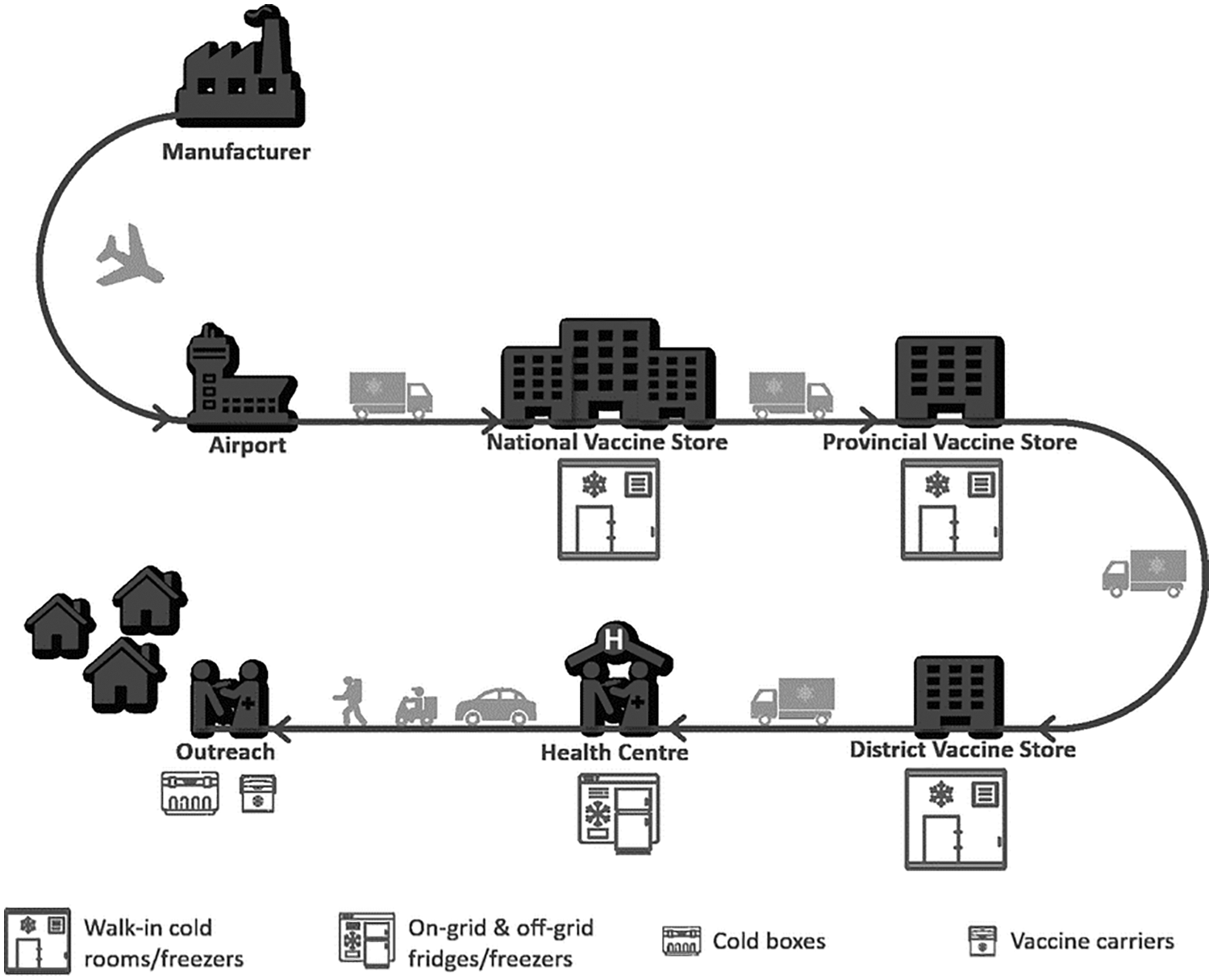
Figure 2: Cold chain vaccine management [17]
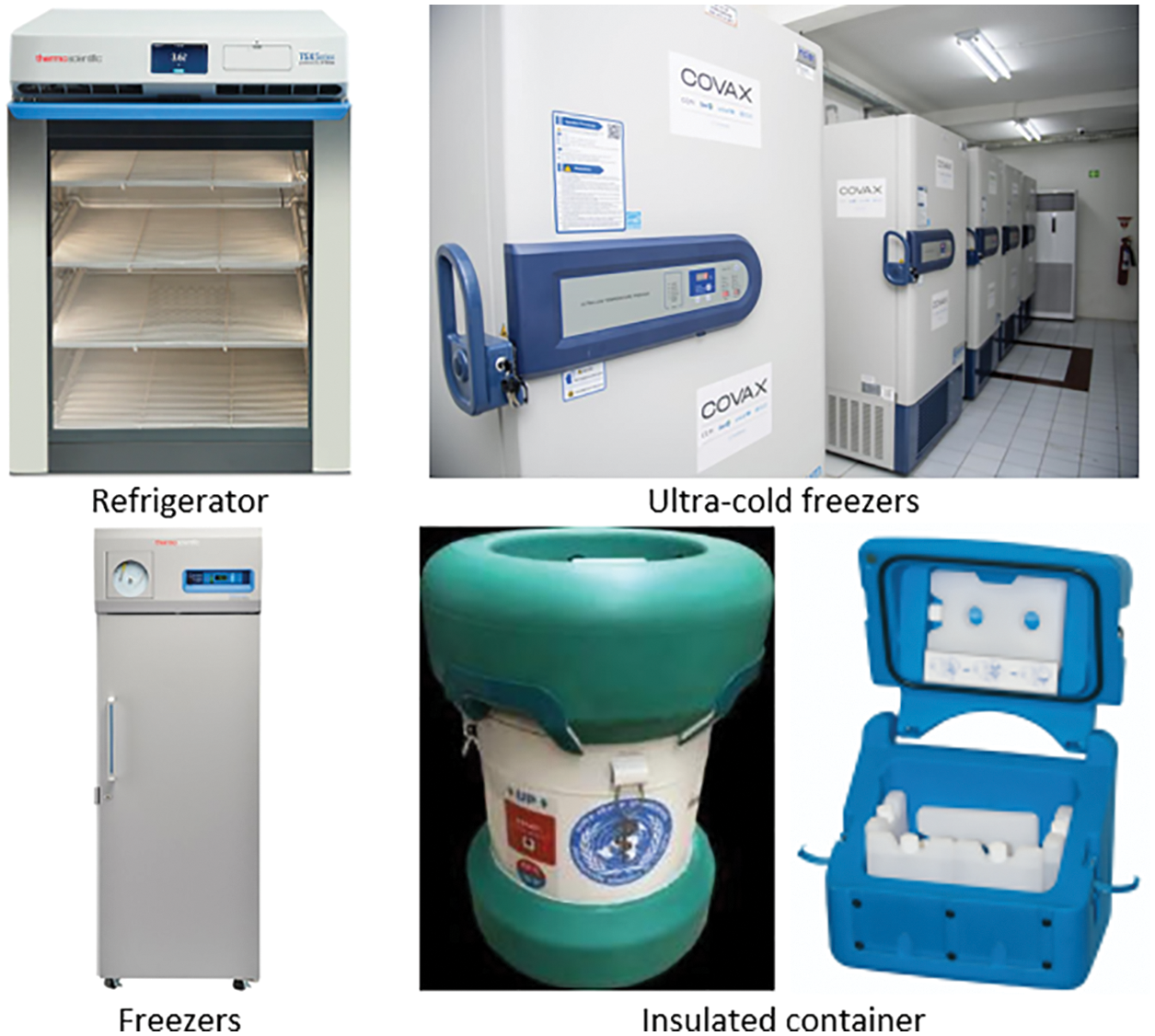
Figure 3: Classification of vaccine cold storage [26–29]
The most important part of cold chain vaccine management is maintaining the temperature until the usage time but several field workers have not been able to ensure adequate maintenance of the required temperature. For example, Hanson et al. [30] summarized that several health workers lack the knowledge on vaccine freeze-damage and its effects on temperature monitoring and the same was also reported by Falcón et al. [31] that staff prioritize protecting vaccines from heat damage, thereby, leading to frequent exposure to freezing temperatures. To maintain the stability of the vaccination process, the government needs to carry out a national stock of COVID-19 vaccines by providing a large number of cold storage rooms.
Previous studies also showed that several officers do not maintain the vaccine temperature according to the manufacturer’s recommendations [31,32]. Therefore, this study was conducted to review the findings of most of these studies on the technology in order to determine those with potential to be applied on vaccine storage in the study area. Furthermore, this research examines the prospects and challenges of implementing a solar-powered cooling system to build vaccine cold storage in remote areas. The result is expected to provide a recommendation related to solar-powered cold storage for COVID-19 vaccines in accordance with existing regional conditions. Furthermore, the results of this recommendation also need to be studied experimentally in the laboratory for actual performance testing.
This research is a literature review by processing data obtained from international reputable journals and literature published by official health institutions such as WHO and the ministry of health. This study also uses report data and general guidelines published by vaccine manufacturers. The reference limit used is the last 5 years.
The keywords used in the reference search focus on cold storage vaccine innovations by utilizing solar power such as absorption cooling system, solar PV cooling system, and intermittent cooling system. Furthermore, this study also reviews the potential for integration of existing solar PV technology with the findings of other cold storage technologies such as ice makers, phase change materials (PCM), and refrigerators. In the end, it is hoped that this research will provide some potential for technology development to meet the supply chain problems of cold storage vaccines.
3.1 Current Solar-Powered Cooling Technology
The solar cooling system is an important part of the technology development for storing vaccines because its presence is intended to increase the efficiency of electricity. Conventional cooling systems drain electrical energy to meet the associated load. It is estimated that cooling systems from households and commercial buildings consume between 38% and 65% of the electrical energy used [33].
The solar cooling technology discussed in this study can is classified based on the source of energy used to operate the technology, such as the absorption, solar PV, and intermittent cooling system [33]. These three cooling system models are used to design and manufacture cold storage for the COVID-19 vaccine.
3.1.1 Absorption Cooling System
The absorption cooling system is similar to the vapor compression cycle. The main difference between the two is the force that causes the pressure difference between the vaporization and condensation process, which allows the steam to move from the low-pressure to the high-pressure region.
In the vapor compression cooling system, a compressor is used, while an absorber and generator are used in the absorption. Low-pressure steam is absorbed with an increase in pressure by the pump while the generator supplies heat. Therefore, the absorber and generator have the ability to replace the compressor function through mechanical and energy inputs. The vapor-compression and absorption cycles are often referred to as work and heat-operated cycles [34].
Heat is provided in various ways, such as using solar collectors, biomass energy, waste, and boilers. The absorption cycle uses two types of substances that are generally different in physical and chemical properties, namely lithium-air (
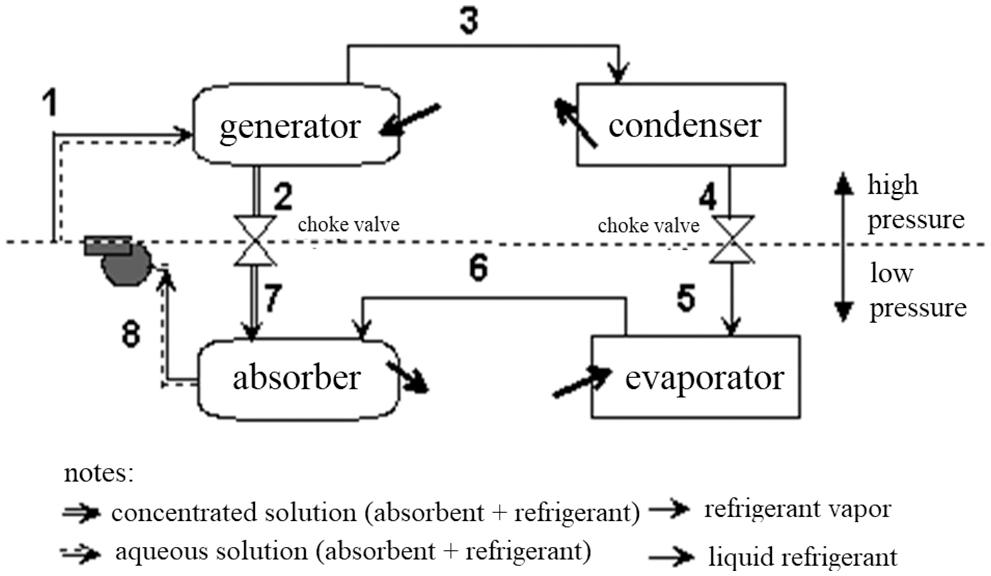
Figure 4: The cycle of absorption cooling system
In this solar photovoltaic cooling system, solar energy is captured through the photovoltaic (PV) process, which converts the heat into DC electrical energy, used to operate a conventional vapor compression cooling system. The cycle is shown in Fig. 5 [40–42].

Figure 5: Solar photovoltaic cooling system
The main components of the cooler with this solar panel system are PV, batteries, and a DC to AC converter. The PV module is the most considered part because changes in its surface temperature tend to affect the solar cells. For instance, the higher the temperature, the lower the voltage output. Therefore, this technology is also equipped with a cooling system [43]. This system can be easily integrated with those that are chiller to provide a cooling room for vaccine storage that saves electricity [44,45].
3.1.3 Intermittent Cooling System
This intermittent cooling system is often also called a solar ice maker because it produces ice cubes used for cooling. Unlike the types discussed above, where absorbing cooling still requires external electrical energy for fluid pumping, this type of refrigerator does not require electrical energy to operate because the cooling process occurs naturally in the evaporator, as shown in Fig. 6 [46,47].
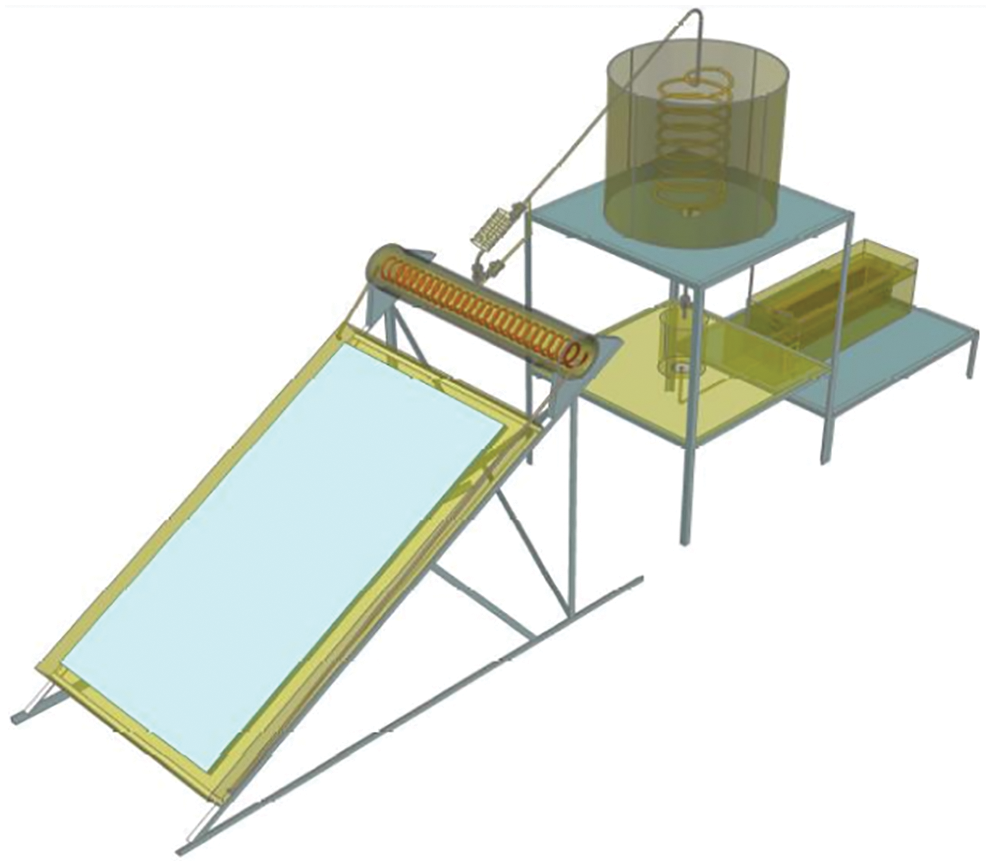
Figure 6: Solar ice maker [46]
The working principle of this technology uses solar heat with a pair of solid-liquid refrigerant absorber materials placed in the pipe, such as methanol-activated carbon. This heating causes a chemical reaction and separates the pair material. Methanol, in the form of gas, flows into the condenser and changes the phase into liquid before it is evaporated and placed in a box filled with water. This process takes place throughout the day. Meanwhile, the chemical reaction is reversed at night, and the solid (carbon) absorber sucks the liquid refrigerant back into the collector. Movement occurs by natural convection, without pumps and other devices. In order to extend the autonomy time, the ice mass in storage becomes the most promising parameter to consider [48].
In the process, the liquid refrigerant evaporates, thereby making the evaporator very cold. This, in turn freezes the water that touches the outside of the evaporator into an ice cube, which is used to create a cold room to meet storage needs [49–52]. Pairs of materials that can be used in the intermittent cooling process are shown in Table 2.

3.2 Mathematical Equation of Thermal Cooling System Absorbance
The input data required to simulate the overall the processes are absorption cycle capacity, hourly ambient temperature, hourly wind velocity, hourly solar radiation intensity are shown in Fig. 7, generator, condenser, evaporator, and absorber temperatures range and heat exchanger effectiveness.
The energy balance of the generator can be described as follows:
where
The energy balance of the condenser can be described as follows [53]:
Energy balance of the expansion valve can be described as follows [53]:
The energy balance for the evaporator can be described as follows [53]:
The energy balance for the absorber can be described as follows [53]:
And the total energy balance is obtained as [53]
The heat balance in the heat exchanger can be written as follows [53]:
3.2.8 Coefficient of Performance (COP)
The coefficient of performance of the refrigeration system is determined as [53,54]
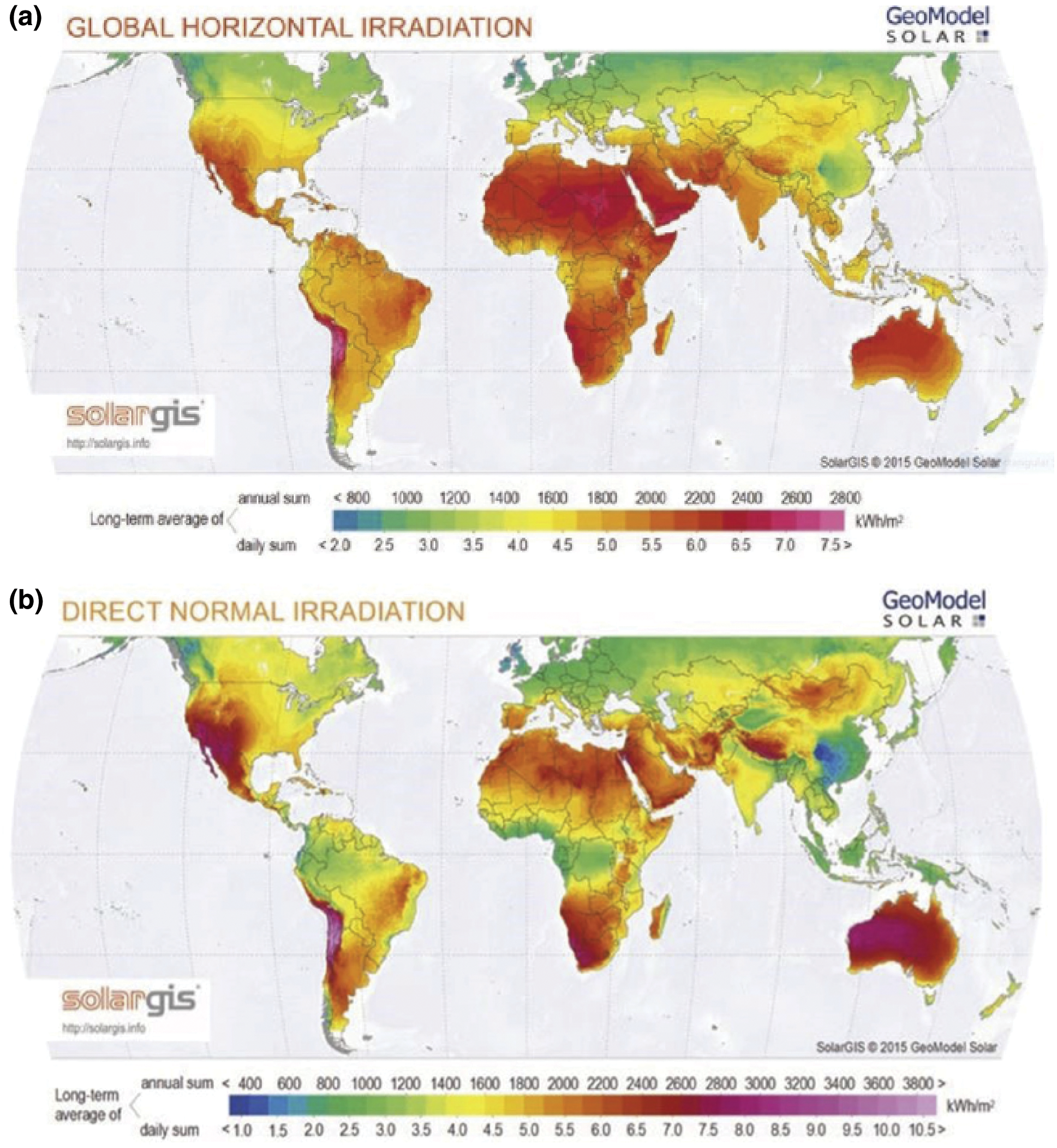
Figure 7: Global mean solar irradiance [55,56]
3.3.1 Scheme 1: Cold Storage Ice Maker
The cold storage ice maker is suitable to be applied in very isolated areas that do not have electrical energy. This technology is designed in the form of a vaccine box where an evaporator is placed on the wall connected to the collector to produce ice cubes at night and used during the day to maintain its room temperature in standard conditions. The vaccine box needs to be insulated to prevent thermal loss during the day.
The volume of cold storage depends on the amount of refrigerant supplied from the collector to the evaporator. Therefore, the size of the collector needs to be designed to accommodate the volume of material pairs proportional to the evaporator. The cold box ice maker concept schematic is shown in Fig. 8.
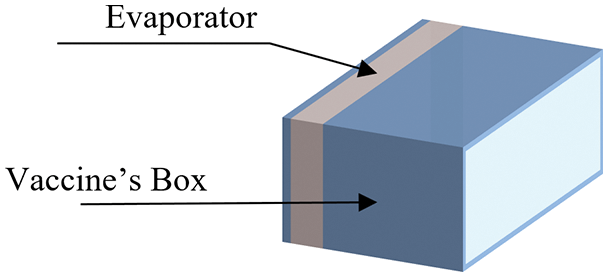
Figure 8: Cold box ice maker
However, one of the disadvantages of this technology is that it cannot be used to produce ice cubes during the day. Consequently, at night, cold box temperature instability becomes possible. Therefore, the addition of PCM and a good insulator is expected to keep the ice cube frozen at night. It is also advisable to use an elliptical pipe [57] and Epsom salt
3.3.2 Scheme 2: Cold Storage Ice Maker-PCM
Scheme-2 is model-1 which is enhanced by adding phase change material (PCM) to the walls of the vaccine’s box to minimize the entry of heat energy. This process is carried out by absorbing heat that passes through the box, thereby maintaining the temperature stability for 24 h and avoiding the ice cube melting process [60]. The PCM should be tightly sealed in a barrier containment, preferably in small microcapsules where PVA-Na2SO4·10H2O and PVA-CaCl2·6H2O are used, to maximize its performance [61].
3.3.3 Scheme 3: PV Refrigerator-Ice Maker
This technology works by assigning the PVC to generate electrical energy, which is then used to operate the cold storage refrigerator installed in the vaccine storage room. The amount of electrical energy that needs to be supplied depends on the compressor power required to meet the load of the cooling chamber wall. The cold storage volume of 3–4
Therefore, the work of the refrigerator compressor is to reduce the cooling load on the vaccine box by decreasing the heat energy entering the vaccine box. Insulators and the addition of PCM have the ability to increase the electrical efficiency of the system [63–66].
Furthermore, to achieve super-efficient thermal conditions, the addition of a solar ice maker is recommended to reduce the cooling load by the refrigerator and PV. This tends to have an impact on the use of batteries at night to operate cold storage and cheaper system prices.
3.3.4 Scheme 4 Absorbing Cooling-PV-Ice Maker
The combination of 3 methods in a solar cooling system can be used to produce medium-sized cold storage of 5--10
Schemes 4 and 3 are suitable for clinics that require a lot of vaccines but their selection is limited by different environmental conditions and infrastructure such as the difficulties in the determination of COP results and prices considering the different clinical conditions. Moreover, Scheme 3 is recommended for clinics in areas facing direct sunlight. This scheme is also observed to have more potential compared to Scheme 4 due to the availability and stability of an existing power source.
This study offered 4 schemes and the potential to be used in procuring vaccine cold storage in remote clinics. Schemes Cold Storage Ice Maker and Cold Storage Ice Maker-PCM are more suitable for very remote clinics with little need for vaccines, while schemes PV Refrigerator-Ice Maker and Absorbing Cooling-PV-Ice Maker has more potential to be used in clinics requiring many vaccines. However, scheme PV Refrigerator-Ice Maker is not suitable for areas with little need for vaccines because it is quite expensive. Interestingly, from all the schemes above, the fifth is produced, which is an application of a solar ice maker on cold storage chiller to reduce cooling, thereby reducing the need for electrical power. Cold storage chillers are widely used in hospitals, commercial buildings, and drug and food companies. In this case, experimental research is being conducted on a combination of the ice maker and cold storage chiller to enhance the chiller’s thermal performance.
Acknowledgement: The authors are grateful to the Research Institutions and Community Service (LPPM) of the Universitas Pendidikan Indonesia, Laboratory of Refrigeration and Air Conditioning, Mr. Nugroho Agung Pambudi as the host of the PPKI research, and the Directorate General of Higher Education (DIKTI) for funding this research.
Funding Statement: This work was supported by the Program Penelitian Kolaborasi Indonesia (PPKI), LPPM Universitas Pendidikan Indonesia, Ministry of Education and Culture of Indonesia.
Conflicts of Interest: The authors declare that they have no conflicts of interest to report regarding the present study.
1. Meo, S. A., Bukhori, I. A., Aakram, J., Meo, A. S., Klonoff, D. C. (2021). COVID-19 vaccines: Comparison of biological, pharmacological characteristics and adverse effects of Pfizer/BioNTech and moderna vaccines. European Review for Medical and Pharmacological Sciences, 25(1), 1663–1669. DOI 10.26355/eurrev_202102_24877. [Google Scholar] [CrossRef]
2. Joshi, A., Vinay, M., Bhaskar, P. (2020). Impact of coronavirus pandemic on the Indian education sector: Perspectives of teachers on online teaching and assessments. Interactive Technology and Smart Education, 18(2), 205–226. DOI 10.1108/ITSE-06-2020-0087. [Google Scholar] [CrossRef]
3. Saraswat, R., Saraswat, D. A. (2020). Research opportunities in pandemic lockdown. Science, 368(6491), 594–595. DOI 10.1126/science.abc3372. [Google Scholar] [CrossRef]
4. Moser, C., Yared, P. (2021). Pandemic lockdown: The role of government commitment. Review of Economic Dynamics, 44, 1–24. DOI 10.1016/j.red.2021.08.001. [Google Scholar] [CrossRef]
5. Alfano, V., Ercolano, S., Ercolano, S. (2021). Stay at home! governance quality and effectiveness of lockdown. Social Indicators Research, 159, 101–123, DOI 10.1007/S11205-021-02742-3. [Google Scholar] [CrossRef]
6. Amer, F., Hammoud, S., Farran, B., Boncz, I., Endrei, D. (2021). Assessment of countries’ preparedness and lockdown effectiveness in fighting COVID-19. Disaster Medicine and Public Health Preparedness, 15(2), e15–e22. DOI 10.1017/DMP.2020.217. [Google Scholar] [CrossRef]
7. Coccia, M. (2021). The relation between length of lockdown, numbers of infected people and deaths of COVID-19, and economic growth of countries: Lessons learned to cope with future pandemics similar to COVID-19 and to constrain the deterioration of economic system. Science of the Total Environment, 775, 145801. DOI 10.1016/J.SCITOTENV.2021.145801. [Google Scholar] [CrossRef]
8. Ghose, A. K. (2020). The pandemic, lockdown and employment. The Indian Journal of Labour Economics, 63(1), 67–71. DOI 10.1007/S41027-020-00258-X/TABLES/5. [Google Scholar] [CrossRef]
9. Atalan, A. (2020). Is the lockdown important to prevent the COVID-19 pandemic? Effects on psychology. Environment and economy-perspective. Annals of Medicine and Surgery, 56, 38–42, DOI 10.1016/J.AMSU.2020.06.010. [Google Scholar] [CrossRef]
10. Firdaus, A. Y. (2020). View of multi-track diplomacy as Indonesia’s strategy in mitigating the COVID-19 pandemic. Journal of Social Political Sciences, 1(3), 168–177. [Google Scholar]
11. Aldila, D., Samiadji, B. M., Simorangkir, G. M., Khosnaw, S. H. A., Shahzad, M. (2021). Impact of early detection and vaccination strategy in COVID-19 eradication program in Jakarta, Indonesia. BMC Research Notes, 14(1), 1–7. DOI 10.1186/S13104-021-05540-9/FIGURES/2. [Google Scholar] [CrossRef]
12. Ariawan, I., Jusril, H. (2020). COVID-19 in Indonesia: Where are we? Acta Medica Indonesiana, 52(3), 193–195. [Google Scholar]
13. Zhao, X., Tatapudi, H., Corey, G., Gopalappa, C. (2021). Threshold analyses on combinations of testing, population size, and vaccine coverage for COVID-19 control in a university setting. PLoS One, 16(8), e0255864. DOI 10.1371/JOURNAL.PONE.0255864. [Google Scholar] [CrossRef]
14. Pambudi, N. A., Sarifudin, A., Gandidi, I. M., Romadhon, R. (2022). Vaccine cold chain management and cold storage technology to address the challenges of vaccination programs. Energy Reports, 8, 955–972. DOI 10.1016/J.EGYR.2021.12.039. [Google Scholar] [CrossRef]
15. Ministry of Health of Canada (2021). COVID-19: Vaccine storage and handling guidance highlights of changes. https://www.canada.ca/en/health-canada/services/drugs-health-. [Google Scholar]
16. Santos, A. F., Gaspar, P. D., de Souza, H. J. L. (2021). Refrigeration of COVID-19 vaccines: Ideal storage characteristics, energy efficiency and environmental impacts of various vaccine options. Energies, 14(7), 1849. DOI 10.3390/en14071849. [Google Scholar] [CrossRef]
17. Mouneer, T. A., Elshaer, A. M., Aly, M. H. (2021). Novel cascade refrigeration cycle for cold supply chain of COVID-19 vaccines at ultra-low temperature-80°C using Ethane (R170) based hydrocarbon pair. World Journal of Engineering and Technology, 9(2), 309--336. DOI 10.4236/wjet.2021.92022. [Google Scholar] [CrossRef]
18. Yan, Y., Pang, Y., Lyu, Z., Wang, R., Wu, X. et al. (2021). The COVID-19 vaccines: Recent development, challenges and prospects. Vaccines, 9(4). DOI 10.3390/vaccines9040349. [Google Scholar] [CrossRef]
19. CDC (2021). Janssen COVID-19 vaccine (Johnson & Johnson) storage and handling summary. https://www.cdc.gov/vaccines/COVID-19/info-by-product/janssen/downloads/janssen-storage-handling-summary.pdf. [Google Scholar]
20. Kumar, A., Dowling, W. E., Román, R. G., Chaudhari, A., Gurry, C. et al. (2021). Status report on COVID-19 vaccines development. Current Infectious Disease Reports, 23(6), 1–12. DOI 10.1007/S11908-021-00752-3/TABLES/2. [Google Scholar] [CrossRef]
21. Shervani, Z., Khan, I., Khan, T., Qazi, U. Y., Batin, A. et al. (2020). COVID-19 vaccine. Advances in Infectious Diseases, 10(3), 195–210. DOI 10.4236/AID.2020.103020. [Google Scholar] [CrossRef]
22. Negahdaripour, M. (2020). The battle against COVID-19: Where do we stand now? Iranian Journal of Medical Sciences, 45(2), 81. DOI 10.30476/IJMS.2020.46357. [Google Scholar] [CrossRef]
23. Mahase, E. (2021). COVID-19: Novavax vaccine efficacy is 86% against UK variant and 60% against South African variant. BMJ, 372, 1. DOI 10.1136/BMJ.N296. [Google Scholar] [CrossRef]
24. Mourshed, M. (2016). Climatic parameters for building energy applications: A temporal-geospatial assessment of temperature indicators. Renewable Energy, 94, 55–71. DOI 10.1016/J.RENENE.2016.03.021. [Google Scholar] [CrossRef]
25. Golan, M. S., Trump, B. D., Cegan, J. C., Linkov, I. (2021). The vaccine supply chain: A call for resilience analytics to support COVID-19 vaccine production and distribution. Physics and Society, 389–437. DOI 10.48550/arXiv.2011.14231. [Google Scholar] [CrossRef]
26. Peters, T., Sayin, L., Wang, X., Fox, T., Hossain, I. et al. (2020). Understanding the cold-chain challenge for COVID-19 vaccinatio. UK: Centre for Sustainable Cooling, University of Birmingham. [Google Scholar]
27. Fonjungo, F., Banerjee, D., Abdulah, R., Diantini, A., Kusuma, A. S. W. et al. (2020). Sustainablefinancing for new vaccines in Indonesia: Challenges and strategies. Sustainability, 12(21), 1–14. DOI 10.3390/su12219265. [Google Scholar] [CrossRef]
28. WHO (2009). E004: Insulated containers. https://apps.who.int/immunization_standards/vaccine_quality/pqs_catalogue/categorypage.aspx?id_cat=18. [Google Scholar]
29. UNICEF Indonesia, Ultra-cold chain freezers: Boosting Indonesia’s COVID-19 vaccine rollout | UNICEF Indonesia. https://www.unicef.org/indonesia/coronavirus/ultra-cold-chain-freezers-boosting-indonesias-COVID-19-vaccine-rollout. [Google Scholar]
30. WHO, Unicef (2021). Ultra-low temperature (ULT) storage and transport for vaccines. https://www.who.int/docs/default-source/coronaviruse/act-accelerator/covax/who_COVID-19_ultracoldchain_overview_en-(1). pdf?sfvrsn=f87b5910_1. [Google Scholar]
31. Hanson, C. M., George, A. M., Sawadogo, A., Schreiber B. (2017). Is freezing in the vaccine cold chain an ongoing issue? A literature review. Vaccine, 35(17), 2127–2133. DOI 10.1016/j.vaccine.2016.09.070. [Google Scholar] [CrossRef]
32. Falcón, V. C., Porras, Y. V. V., Altamirano, C. M. G., Kartoglu, U. (2020). A vaccine cold chain temperature monitoring study in the United Mexican States. Vaccine, 38(33), 5202–5211. DOI 10.1016/J.VACCINE.2020.06.014. [Google Scholar] [CrossRef]
33. Siecker, J., Kusakana, K., Numbi, B. P. (2017). A review of solar photovoltaic systems cooling technologies. Renewable and Sustainable Energy Reviews, 79, 192–203. DOI 10.1016/j.rser.2017.05.053. [Google Scholar] [CrossRef]
34. Elberry, M. F., Elsayed, A. A., Teamah, M. A., Abdel-Rahman, A. A., Elsafty, A. F. (2018). Performance improvement of power plants using absorption cooling system. Alexandria Engineering Journal, 57(4), 2679–2686. DOI 10.1016/J.AEJ.2017.10.004. [Google Scholar] [CrossRef]
35. López-Zavala, R., Velázquez-Limón, N., González-Uribe, L. A., Aguilar-Jiménez, J. A., Alvarez-Mancilla, J. et al. (2019). A novel LiBr/H2O absorption cooling and desalination system with three pressure levels. International Journal of Refrigeration, 99, 469–478. DOI 10.1016/J.IJREFRIG.2019.01.003. [Google Scholar] [CrossRef]
36. Li., Z., Jing, Y., Liu, J. (2016). Thermodynamic study of a novel solar LiBr/H2O absorption chiller. Energy and Buildings, 133, 565–576. DOI 10.1016/J.ENBUILD.2016.10.022. [Google Scholar] [CrossRef]
37. Agyenim, F. (2016). The use of enhanced heat transfer phase change materials (PCM) to improve the coefficient of performance (COP) of solar powered LiBr/H2O absorption cooling systems. Renewable Energy, 87, 229–239. DOI 10.1016/J.RENENE.2015.10.012. [Google Scholar] [CrossRef]
38. Porumb, R., Porumb, B., Balan, M. (2017). Numerical investigation on solar absorption chiller with LiBr-H2O operating conditions and performances. Energy Procedia, 112, 108–117. DOI 10.1016/J.EGYPRO.2017.03.1071. [Google Scholar] [CrossRef]
39. Nikbakhti, R., Wang, X., Hussein, A. K., Iranmanesh, A. (2020). Absorption cooling systems–Review of various techniques for energy performance enhancement. Alexandria Engineering Journal, 59(2), 707–738. DOI 10.1016/J.AEJ.2020.01.036. [Google Scholar] [CrossRef]
40. Pang, W., Y., H., Zhang, Y., Yan, H. (2019). Solar photovoltaic based air cooling system for vehicles. Renewable Energy, 130, 25–31. DOI 10.1016/J.RENENE.2018.06.048. [Google Scholar] [CrossRef]
41. Charfi, W., Chaabane, M., Mhiri, H., Bournot, P. (2018). Performance evaluation of a solar photovoltaic system. Energy Reports, 4, 400–406. DOI 10.1016/J.EGYR.2018.06.004. [Google Scholar] [CrossRef]
42. Sargunanathan, S., Elango, A., Mohideen, S. T. (2016). Performance enhancement of solar photovoltaic cells using effective cooling methods: A review. Renewable and Sustainable Energy Reviews, 64, 382–393. DOI 10.1016/J.RSER.2016.06.024. [Google Scholar] [CrossRef]
43. Sarafoji, P., Mariappan, V., Anish, R., Karthikeyan, K., Reddy, J. (2020). Performance study of solar photovoltaic cold storage system using phase change materials. Materials Today: Proceedings, 46(19), 9623–9629. DOI 10.1016/J.MATPR.2020.07.116. [Google Scholar] [CrossRef]
44. Uddin, M. R., Mahmud, S., Salehin, S., Bhuiyan, M. A. Z., Riaz, F. et al. (2021). Energy analysis of a solar driven vaccine refrigerator using environment-friendly refrigerants for off-grid locations. Energy Conversion and Management: X, 11, 1–15. DOI 10.1016/J.ECMX.2021.100095. [Google Scholar] [CrossRef]
45. Allouhi, A., Kousksou, T., Jamil, A., Agrousz, Y., Bouhal, T. et al. (2016). Performance evaluation of solar adsorption cooling systems for vaccine preservation in Sub-Saharan Africa. Applied Energy, 170, 232–241. DOI 10.1016/J.APENERGY.2016.02.123. [Google Scholar] [CrossRef]
46. Garcia, J. M., Rosa, A. (2019). Theoretical study of an intermittent water-ammonia absorption solar system for small power ice production. Sustainability, 11(12), 3346. DOI 10.3390/SU11123346. [Google Scholar] [CrossRef]
47. Modi, N., Pandya, B. (2021). Integration of evacuated solar collectors with an adsorptive ice maker for hot climate region. Energy and Built Environment, 3(2), 181–189. DOI 10.1016/J.ENBENV.2021.01.001. [Google Scholar] [CrossRef]
48. Jensen, J. K., Busk, C., Cording, C., Pedersen, P. H., Markussen, W. B. (2019). Extending the autonomy time of an icelined solar powered vaccine cooler. Proceedings of the 25th IIR International Congress of Refrigeration International Institute of Refrigeratio, vol. 2019, pp. 3460–3467. Montreal, Canada. DOI 10.18462/IIR.ICR.2019.1006. [Google Scholar] [CrossRef]
49. Sah, R. P., Choudhury, B., Das, R. K. (2016). A review on low grade heat powered adsorption cooling systems for ice production. Renewable and Sustainable Energy Reviews, 62, 109–120. DOI 10.1016/J.RSER.2016.04.036. [Google Scholar] [CrossRef]
50. Attalla, M., Sadek, S., Ahmed, M. S., Shafie, I. M., Hassan, M. (2018). Experimental study of solar powered ice maker using adsorption pair of activated carbon and methanol. Applied Thermal Engineering, 141, 877–886. DOI 10.1016/J.APPLTHERMALENG.2018.06.038. [Google Scholar] [CrossRef]
51. Ambarita, H., Kawai, H. (2016). Experimental study on solar-powered adsorption refrigeration cycle with activated alumina and activated carbon as adsorbent. Case Studies in Thermal Engineering, 7, 36–46. DOI 10.1016/J.CSITE.2016.01.006. [Google Scholar] [CrossRef]
52. Wang, R. Z., Pan, Q. W., Xu, Z. Y. (2016). Solar-powered adsorption cooling systems. Advances in Solar Heating and Cooling, 299–328. DOI 10.1016/B978-0-08-100301-5.00012-6. [Google Scholar] [CrossRef]
53. Iffa, R. B., Bouaziz, N., Kairouani, L. (2017). Optimization of absorption refrigeration systems by design of experiments method. Energy Procedia, 139, 280–287. DOI 10.1016/J.EGYPRO.2017.11.209. [Google Scholar] [CrossRef]
54. Sarifudin, A., Wijayanto, D. S., Widiastuti, I., Pambudi, N. A. (2020). Dataset of comprehensive thermal performance on cooling the hot tube surfaces of vortex tube at different pressure and fraction. Data in Brief, 30, 105611. DOI 10.1016/J.DIB.2020.105611. [Google Scholar] [CrossRef]
55. Silalahi, D. F., Blakers, A., Stocks, M., Lu, B., Cheng, C. et al. (2021). Indonesia’s vast solar energy potential. Energies, 14(17), 2021. DOI 10.3390/en14175424. [Google Scholar] [CrossRef]
56. Agbo, E. P., Edet, C. O., Magu, T. O., Njok, A. O., Ekpo, C. M. et al. (2021). Solar energy: A panacea for the electricity generation crisis in Nigeria. Heliyon, 7, 5. DOI 10.1016/J.HELIYON.2021.E07016. [Google Scholar] [CrossRef]
57. Yadav, S. K., Ziyad, D., Kumar, A. (2019). Numerical investigation of isothermal and non-isothermal ice slurry flow in horizontal elliptical pipes. International Journal of Refrigeration, 97, 196–210. DOI 10.1016/J.IJREFRIG.2018.10.013. [Google Scholar] [CrossRef]
58. Kharbanda. J. S., Yadav. S. K., Soni. V., Kumar. A. (2020). Modeling of heat transfer and fluid flow in epsom salt (MgSO4·7H2O) dissociation for thermochemical energy storage. Journal of Energy Storage, 31, 101712. DOI 10.1016/J.EST.2020.101712. [Google Scholar] [CrossRef]
59. Singh, S., Ramadesigan, V. (2017). Advances in energy research. In: Selected papers from ICAER, vol. 1. Singapore. DOI 10.1007/978-981-15-2666-4. [Google Scholar] [CrossRef]
60. Irsyad, M., Pasek, A. D., Indartono, Y. S., Pratomo, A. W. (2017). Heat transfer characteristics of building walls using phase change material. IOP Conference Series: Earth and Environmental Science, 60(1), 1–6. DOI 10.1088/1755-1315/60/1/012028. [Google Scholar] [CrossRef]
61. Alkan, C., Döğüşcü, D. K., Gottschalk, A., Ramamoorthi, U., Kumar, A. et al. (2016). Polyvinyl alcohol-salt hydrate mixtures as passive thermal energy storage systems. Energy Procedia, 91, 1012–1017. DOI 10.1016/J.EGYPRO.2016.06.269. [Google Scholar] [CrossRef]
62. Shaibani, A. R., Keshtka, M. M., Sardari, P. T. (2019). Thermo-economic analysis of a cold storage system in full and partial modes with two different scenarios: A case study. Journal of Energy Storage, 24, 100783. DOI 10.1016/J.EST.2019.100783. [Google Scholar] [CrossRef]
63. Lakshan, R. R., Rosini, A. M., Sathiyan, K., Gangadharan, D., Sathyan, D. et al. (2021). Study on thermal insulating properties of PCM incorporated wall panels. Materials Today: Proceedings Provides, 46, 5118–5122. DOI 10.1016/J.MATPR.2020.10.501. [Google Scholar] [CrossRef]
64. Labihi, A., Ouikhalfan, M., Chehouani, H., Benhamou, B. (2021). PCM incorporation into a cavity wall as an insulator and phase shifter: Experimental investigations and numerical modeling. International Journal of Energy Research, 45(11), 16728–16740. DOI 10.1002/ER.6918. [Google Scholar] [CrossRef]
65. Zhang, M., Xiao, Q., Chen, C., Li, L., Yuan, W. (2020). Developing a heat-insulating composite phase change material with light-to-thermal conversion performance from graphene oxide/silica hybrid aerogel. Applied Thermal Engineering, 174, 115303. DOI 10.1016/J.APPLTHERMALENG.2020.115303. [Google Scholar] [CrossRef]
66. Khdair, A. I., Rumman, G. A., Basha, M. (2022). Developing building enhanced with PCM to reduce energy consumption. Journal of Building Engineering, 48, 103923. DOI 10.1016/J.JOBE.2021.103923. [Google Scholar] [CrossRef]
 | This work is licensed under a Creative Commons Attribution 4.0 International License, which permits unrestricted use, distribution, and reproduction in any medium, provided the original work is properly cited. |